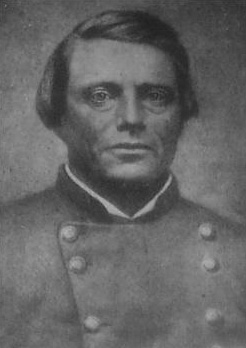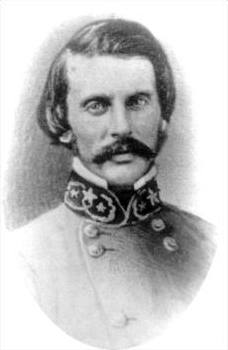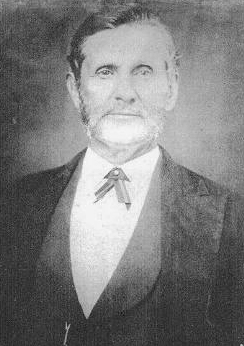
Thomas Green was an American soldier and lawyer, who took part in the Texan Revolution of 1835–36, serving under Sam Houston, who rewarded him with a land grant. Green was clerk of the Texas Supreme Court until the outbreak of the Civil War, when he became a Confederate cavalry leader. After winning several victories, including the Battle of Valverde and the recapture of Galveston, he was promoted brigadier and assigned command of the cavalry division of the Trans-Mississippi Department. In the Red River Campaign, he was mortally wounded while charging a fleet of Federal gunboats. The Union naval commander David Dixon Porter paid tribute to Green as a serious loss to the Confederacy.

Walker's Greyhounds was the popular name for a division of the Confederate States Army under Major-General John George Walker, composed exclusively of units from Texas. It fought in the Western Theater and the Trans-Mississippi Department, gaining its nickname because the men were able to move long distances rapidly on foot.

The 33rd Illinois Infantry Regiment was an infantry regiment from Illinois that served in the Union Army during the American Civil War. A number of the soldiers were college students and graduates, and for a time the regiment included a 17-piece band. The unit fought at Fredericktown in 1861, Cotton Plant in 1862, the Vicksburg campaign and Fort Esperanza in 1863, and at Spanish Fort in 1865. The original enlistees were mustered out in October 1864 while the veterans and recruits were mustered out in December 1865.

The Battle of Lake Providence was fought on June 9, 1863, during the Vicksburg campaign of the American Civil War. Confederate troops from the Trans-Mississippi Department were trying to relieve Union pressure during the Siege of Vicksburg. Major General Richard Taylor, primarily utilizing Walker's Greyhounds, prepared a three-pronged attack against Union positions at Milliken's Bend, Young's Point, and Lake Providence. The strike against Lake Providence was conducted by 900 men led by Colonel Frank Bartlett.

Chretien Point Plantation is a pre-Civil War twelve room red brick mansion, located on twenty acres on the banks of Bayou Bourbeaux, two miles southwest of Sunset, Louisiana in St. Landry Parish. A Civil War battle was fought on the plantation grounds and Jean Lafitte was a tenant. The mansion was listed on the National Register of Historic Places in 1977.

The 18th Texas Infantry Regiment was a unit of volunteers recruited in Texas that fought in the Confederate States Army during the American Civil War. The regiment was enrolled in Confederate service in May 1862 and always campaigned west of the Mississippi River in the region known as the Trans-Mississippi Department. The unit was assigned to the Texas infantry division known as Walker's Greyhounds. The regiment fought at Milliken's Bend, Richmond (La.), and Bayou Bourbeux in 1863 and Mansfield, Pleasant Hill, and Jenkins' Ferry in 1864. The regiment disbanded in mid-May 1865, but its formal surrender date was 26 May 1865.

The 15th Texas Infantry Regiment was a unit of volunteers recruited in Texas that fought in the Confederate States Army during the American Civil War. The regiment organized in early 1862 and throughout the war served west of the Mississippi River in the Trans-Mississippi Department. In October 1863, the unit was assigned to a brigade led by the French aristocrat Prince Camille de Polignac. The 15th Texas Infantry fought at Stirling's Plantation and Bayou Bourbeux in 1863 and Mansfield, Pleasant Hill, and Yellow Bayou in 1864. The regiment disbanded in May 1865, though the formal surrender date was 26 May 1865.

The 2nd Louisiana Cavalry Regiment was a unit of mounted volunteers recruited in Louisiana that fought in the Confederate States Army during the American Civil War. Breazeale's Cavalry Battalion was formed in July 1862 and was augmented by five additional companies in September 1862 to form a regiment. It served for the entire war west of the Mississippi River in the Trans-Mississippi Department. The regiment fought at Georgia Landing, Fort Bisland, Irish Bend, and Brashear City in 1863 and Henderson's Hill and Mansfield in 1864. Afterward, the regiment fought in minor skirmishes before the Trans-Mississippi's final surrender on 26 May 1865.

The 4th Texas Cavalry Regiment was a unit of mounted volunteers from Texas that fought in the Confederate States Army during the American Civil War. The unit was organized in September 1861 with the aim of seizing New Mexico Territory. In 1862, the regiment served in the unsuccessful New Mexico Campaign. In 1863, it was in action at Galveston, Fort Bisland, Irish Bend, Second Donaldsonville, Kock's Plantation, Sterling's Plantation, and Bayou Bourbeau. In 1864, the regiment fought at Mansfield and Pleasant Hill in the Red River Campaign. The unit surrendered in May 1865.

The 7th Texas Cavalry Regiment was a unit of mounted volunteers from Texas that fought in the Confederate States Army during the American Civil War. In the summer of 1861, the regiment was organized and mustered into Confederate service. In November 1861, it was assigned to a brigade that was tasked with capturing New Mexico Territory. In 1862, the regiment served in the unsuccessful New Mexico Campaign. In 1863, it was in action at Galveston, Second Donaldsonville, Kock's Plantation, and Bayou Bourbeau. In 1864, the regiment fought at Mansfield and Pleasant Hill in the Red River Campaign. The unit disbanded while in Texas in May 1865.

The 22nd Texas Cavalry Regiment was a unit of mounted volunteers from Texas that fought in the Confederate States Army during the American Civil War. The regiment first began organizing in late 1861 and by July 1862, it moved to the Indian Territory. The unit fought at Newtonia and McGuire's Store in fall 1862 and was dismounted soon after. The regiment fought as infantry at Prairie Grove in December 1862. It traveled to Louisiana in March 1863 where it joined a brigade led by Camille de Polignac. In 1864 the regiment fought at Mansfield, Pleasant Hill, and Yellow Bayou during the Red River Campaign. In March 1865 the regiment marched to Texas where it disbanded in May.

The 19th Texas Cavalry Regiment was a unit of mounted volunteers from Texas that fought in the Confederate States Army during the American Civil War. The regiment mustered into Confederate service at the end of March 1862. It moved to Arkansas in fall 1862 and managed to avoid being dismounted as infantry, instead serving in William Parsons' cavalry brigade. The regiment fought at Cape Girardeau in 1863. The unit operated against Union supply lines and skirmished with Union forces in Arkansas and Louisiana. It arrived too late to take part in the main battles of the Red River campaign of 1864, but fought at Yellow Bayou. In 1865, the unit moved to Texas where it disbanded in May 1865.

The 2nd Texas Cavalry Regiment was a unit of mounted volunteers from Texas that fought in the Confederate States Army during the American Civil War. The unit was organized in May 1861 as the 2nd Texas Mounted Rifles. In early 1862, the regiment took part in the unsuccessful New Mexico Campaign before retreating to Texas. In April 1862 the unit reorganized at Austin, Texas, as the 2nd Texas Cavalry. In January 1863, part of the regiment helped recapture Galveston while another part was captured at Arkansas Post. After moving to Louisiana, the unit fought at LaFourche Crossing, Second Donaldsonville, Kock's Plantation, Sterling's Plantation, and Bayou Bourbeux. It returned to Texas in winter 1863 and remained there until the surrender in June 1865.

The 31st Texas Cavalry Regiment was a unit of mounted volunteers from Texas that fought in the Confederate States Army during the American Civil War. Trevezant C. Hawpe organized the regiment in early 1862 with recruits mostly from Dallas County, Texas, and surroundings. In June 1862, it marched to Arkansas where it joined a brigade led by Douglas H. Cooper. The unit fought at Newtonia and McGuire's Store in autumn 1862 and subsequently dismounted to serve as infantry. The regiment served at Prairie Grove in December 1862. It moved to Louisiana in February 1863 at which time Hawpe resigned. The unit helped defeat a Federal force at Stirling's Plantation in September 1863. The following month it joined a brigade led by Camille de Polignac. In 1864 the regiment fought at Mansfield, Pleasant Hill, and Yellow Bayou during the Red River Campaign. In March 1865 the regiment marched to Texas where it disbanded in May.

The 34th Texas Cavalry Regiment was a unit of mounted volunteers from Texas that fought in the Confederate States Army during the American Civil War. Almerine M. Alexander organized the regiment from north Texas recruits in the winter of 1861–1862. The unit marched to Indian Territory in May 1862 where it joined a brigade commanded by Douglas H. Cooper. The regiment fought at Newtonia and McGuire's Store in fall 1862 afterward was dismounted. The regiment served as infantry at Prairie Grove in December 1862. It received orders to transfer to Louisiana in April 1863. The regiment joined a brigade led by Camille de Polignac in July 1863. The following year, the unit fought at Mansfield, Pleasant Hill, and Yellow Bayou during the Red River Campaign. In March 1865 the regiment was assigned to the Texas Infantry Division. Soon after, it marched to Texas where it disbanded in May 1865.
The 36th Texas Cavalry Regiment was a unit of mounted volunteers from Texas that fought in the Confederate States Army during the American Civil War. The regiment was organized in March 1862 at Belton, Texas and surgeon Peter C. Woods was appointed to command it. The unit patrolled the Texas Gulf Coast and then spent the winter of 1862–1863 at Port Lavaca, Texas. It marched to Brownsville, Texas, in spring 1863 and later joined Hamilton P. Bee's brigade. This brigade transferred to Louisiana where it fought at Mansfield, Pleasant Hill, Blair's Landing, and Yellow Bayou during the Red River campaign in 1864. Afterward, the regiment traveled to Crockett, Texas, and then Galveston, where it was present when the men were paroled in June 1865.

The 1st Louisiana Field Battery was an artillery unit recruited from volunteers in Louisiana that fought in the Confederate States Army during the American Civil War. The battery mustered into Confederate service in October 1861. The unit traveled to Fort Jackson in early 1862 and took part in the defense of Forts Jackson and St. Philip. The soldiers became prisoners when the forts surrendered and the battery reformed at Franklin after their prisoner exchange. The battery fought at Fort Bisland and Irish Bend in 1863. Later in the year the battery engaged Union shipping on the rivers in several actions. In 1864 the battery briefly fought at Mansfield before its commander was killed while engaging Union gunboats on the Red River. The unit also fought at Mansura and Yellow Bayou. The battery was in Texas when the Trans-Mississippi Department surrendered in May 1865.
The 5th Louisiana Field Battery was an artillery unit recruited from volunteers in Louisiana that fought in the Confederate States Army during the American Civil War. The Pelican Artillery organized on 31 October 1862, recruiting men mostly from St. James Parish, Louisiana. The battery first saw action in November 1862 against Union gunboats on Bayou Teche. In April 1863, the unit distinguished itself at Fort Bisland and it fought a skirmish at Vermillion Bayou a few days later. In July 1863, the battery fired on Federal shipping at Gaudet's Plantation near Donaldsonville, Louisiana, and fought at Kock's Plantation. In April 1864, it served during the Red River campaign and was present, but not engaged at the battles of Mansfield and Pleasant Hill. In May 1864, the unit was engaged at Mansura and Yellow Bayou. The battery surrendered in early June 1865 while at Tyler, Texas. A total of 183 men enlisted in the battery during the war; 2 were killed in action, 5 died from disease, and 1 drowned.

The 1st Texas Partisan Rangers was a unit of mounted volunteers from Texas that fought in the Confederate States Army during the American Civil War. Walter P. Lane began organizing the unit at Jefferson, Texas, in June 1862 for service in the Trans-Mississippi theater. In November 1862, the regiment marched to Arkansas where it fought at Prairie Grove and Van Buren. After reorganizing at Jefferson, the partisan rangers traveled to Louisiana in April 1863. The regiment was at Second Donaldsonville but did not come into action. In 1863, it fought at Kock's Plantation, Sterling's Plantation, and Bayou Bourbeux. The unit spent the 1863–1864 winter near Galveston. In 1864, the unit was in action during the Red River Campaign, fighting at Mansfield, Pleasant Hill, Monett's Ferry, and Yellow Bayou. The partisan rangers went back to Texas in December 1864 and remained near Houston until the surrender of the Trans-Mississippi Department on 26 May 1865.

The 2nd Texas Cavalry Regiment (Arizona Brigade) was a unit of mounted volunteers from Texas that fought in the Confederate States Army during the American Civil War. In May 1862, the Confederate States Army authorized John R. Baylor to organize five battalions of Partisan Rangers of six companies each. Their purpose was to recapture the southwestern territories lost during the New Mexico campaign, hence the name Arizona Brigade. One of the battalions was commanded by George Wythe Baylor, John Baylor's younger brother. Later, George Baylor's battalion was combined with a small battalion led by John W. Mullen and an additional company to form a regiment. In April 1863, the new regiment left Texas under George Baylor's command and marched to Louisiana. The regiment fought at Brashear City, Sterling's Plantation, and Bayou Bourbeux before wintering near Galveston in 1863–1864. The regiment was in action during the 1864 Red River Campaign, fighting at Mansfield, Pleasant Hill, Monett's Ferry, and Yellow Bayou. After campaigning in Arkansas in September 1864, the regiment returned to Texas near Houston in December. The regiment received orders to dismount which were resented by the soldiers. After an argument about the orders, Baylor shot his superior officer John A. Wharton to death. The unit disbanded after the surrender of the Trans-Mississippi Department on 26 May 1865.

















